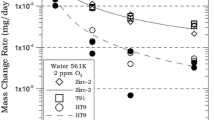Abstract
A Canada Deuterium Uranium (CANDU) reactor has hundreds of carbon steel feeder pipes that are connected at one end to the fuel channels at the reactor face and are connected at the other end to the reactor inlet and outlet headers above the reactor. The production of hydrogen gas from metal–water interaction at high temperatures is a major concern during a severe accident in a nuclear reactor. It is generally accepted that the main source of hydrogen gas during a severe accident is the chemical interaction of Zircaloy fuel cladding and the water coolant. However, it has recently been suggested that the amount of hydrogen produced by the oxidation of carbon steel located outside of a CANDU core could exceed that produced by zirconium oxidation. In this work, the linear and parabolic oxidation rate constants of CANDU feeder carbon steel, in the temperature range of 600–1,100°C, were measured to be W/t = 1.806 × 103 exp (− 126,337/RT) and W2/t = 1.879 × 105 exp (− 135,835/RT), respectively. For parabolic steam oxidation beginning at roughly 90 minutes after reaching steady-state heating temperatures, the latter equation should be used. These rates are about a factor of 5–10 greater than oxidation rates measured in 304L stainless steel and in zirconium specimens, meaning that the carbon steel oxidation can be significant in an accident.







Similar content being viewed by others
References
L. S. Lebel, A. C. Morreale, K. Volodymyr, M. J. Brown, and S. Gyepi-Garbrah, Severe accident consequence mitigation by filtered containment venting at Canadian nuclear power plants. Annals of Nuclear Energy 102, 2017 (297–308).
S. Nijhawan, in Conversations about Challenges in Multi-Unit CANDU Reactor Severe Accident Mitigation Strategies, NUTHOS-11: The 11th International Topical Meeting on Nuclear Reactor Thermal Hydraulics, Operation and Safety. (Gyeongju, Korea, 2016).
B. Hanna, CATHENA: A thermalhydraulic code for CANDU analysis. Nuclear Engineering and Design 180, (2), 1998 (113–131).
H.T. Abuluwefa, Characterization of oxides (scale) growth of low carbon steel during reheating, PhD thesis, McGill U., Montreal, QC, Canada (1996).
L. Tomlinson, Mechanism of corrosion of carbon and low alloy ferritic steels by high temperature water. Corrosion 37, (10), 1981 (591–596).
C. Zhang, Oxide layer thickness modification. Masters Science thesis, Luleå University, Sweden (2012)
C. Koike, J. Matsuno, and H. Chihara, Variations in the infrared spectra of Wüstite with defects and disorder. Astrophysical Journal 845, (115), 2017 (1–11).
R. Hazen and R. Jeanloz, Wustite (Fe1-xO) A-review of its defect structure and physical properties. RGSP 22, 1984 (37–46).
N. Bertrand, C. Desgranges, D. Poquillon, M. C. Lafony, and D. Monceau, Iron oxidation at low temperature (260–500 °C) in air and the effect of water vapor. Oxidation of Metals 73, 2010 (139–162).
J. Y. Yun, S. A. Ha, C. Y. Kang, and J. P. Wang, Oxidation behavior of low carbon steel at elevated temperatures in oxygen and water vapor. Steel Research 84, 2013 (1254).
J. Armitt et al., The spalling of steam grown oxide. Technical planning study, CERL, England, FP-686, 76-655, final report, (1978).
I. G. Wright and B. A. Pint, An assessment of the high-temperature oxidation behavior of Fe-Cr steels in water vapor and steam, Paper 02377. NACE International Corrosion, Denver, Colorado, US (2002).
A. S. Khanna, in High temperature oxidation, Chapter 6, Handbook of environmental degradation of materials 3rd Rd., Indian Institute of Technology, Bombay, Maharashtra, India, pp. 117-132, (2018).
C. T. Fujii and R. A. Meussner, The mechanism of the high-temperature oxidation of iron-chromium alloys in water vapor. Journal of the Electrochemical Society 111, 1964 (1215–1221).
J. T. Bittel, L. H. Sjodahl, and J. F. White, Oxidation of 304L stainless steel by steam and by air. Corrosion, NACE 25, 1969 (7–14).
K. Sachs and C. W. Tuck, Scale growth during re-heating cycles. Materials Corrosion 21, 1970 (945–954).
T. Ishida, Y. Harayama, and S. Yaguchi, Oxidation of 304 stainless steel in high-temperature steam. Journal of Nuclear Materials 140, 1986 (74–84).
E. Essuman, G. H. Meier, J. Żurek, M. Hänsel, and W. J. Quadakkers, The effect of water vapor on selective oxidation of Fe-Cr alloys. Oxidation of Metals 69, 2008 (143–162).
D.H. Lister, J. Slade, and N. Arbeau, in The accelerated corrosion of CANDU outlet feeders – observations, possible mechanisms and potential remedies, University of New Brunswick and Point Lepreau Generating Station, CA9900002, eds. A. Oliva, CNS proceedings of the 1997 CNA/CNS annual conference on powering Canada's future Vol. 1, 2, (1997) p. 1122.
W. D. Callister Jr., Materials Science and Engineering, An Introduction, 4th ed (John Wiley and Sons Inc., 1997),.
Acknowledgements
This work was supported by the Science and Technology program at CNL. The authors would like to thank Yuqing Ding at CNL for providing feeder pipe material for preparing specimens. Thanks is expressed to Andrew Morreale for his capacity of project lead who provided helpful support. Appreciation is also expressed to technician Brett Culver from Netzsch Instruments who helped setup the TGA and for answering many technical questions. Acknowledgment is also due to Liana Orlovskaya for measuring the chemical composition of a feeder pipe specimen using an ICP-MS.
Funding
This work was supported by the Science and Technology program at the Canadian Nuclear Laboratories, under the Government of Canada, funded by Aaron Quastel.
Author information
Authors and Affiliations
Corresponding author
Additional information
Publisher's Note
Springer Nature remains neutral with regard to jurisdictional claims in published maps and institutional affiliations.
Rights and permissions
About this article
Cite this article
Quastel, A.D., West, A. & Young, G. Feeder Pipe Oxidation in the Presence of Steam During a Nuclear Reactor Accident. High Temperature Corrosion of mater. 99, 399–413 (2023). https://doi.org/10.1007/s11085-023-10158-2
Received:
Revised:
Accepted:
Published:
Issue Date:
DOI: https://doi.org/10.1007/s11085-023-10158-2



